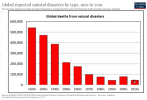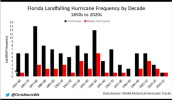I have to disagree with you on the tornado reporting considering the improvement in radar and forecasting. The NWS forecasts severe weather days in advance, and no matter how desolate the area, an army of chasers descends to document what is going on.
Using radar technology for tornado detection has been in effect since the 1950s, Doppler radar since the 1970s, the NWS NEXRAD system since the late 1980's and early 1990's. These provide the most detailed information. however the range of a doppler radar for detecting tornadoes is only about 120 to 130 miles. Yes, there are about 160 radars in. the US, but that leaves many areas without detection, especially where terrain blocks the radars. Also there is the curvature of the earth to consider. Dopplar radar beams travel only in a straight direction, so detection of tornadoes that actually touch down and do damage is often not possible.
As for satellites, they cannot directly detect tornadoes, but only the tops of cloud formations. Small features associated with tornadoes cannot be directly observed.
Per ChatGPT:
"Human observation of tornadoes remains a crucial component of severe weather monitoring and reporting. Despite advances in technology, such as radar and satellite systems, human observers provide valuable, often irreplaceable insights into tornado behavior and impacts. Here's an evaluation of the importance and effectiveness of human observations:
Importance of Human Observation:
- Ground Truth Verification: Human observers provide "ground truth" data that is essential for verifying and refining the detections made by radar and satellite systems. This data helps confirm whether storm features detected remotely are indeed producing tornadoes on the ground.
- Real-Time Reporting: Storm chasers and trained spotters often report in real-time, providing immediate assessments of tornado location, movement, size, and damage. This information can be critical for issuing and updating warnings to the public and emergency services.
- Detailed Descriptions of Impact: Observers can provide detailed descriptions of the damage, which is vital for assessing the severity and potential impact of a tornado. This information is used to enhance safety protocols and improve future preparedness.
- Research and Education: Eyewitness accounts and photographs contribute to scientific research and help in educating the public and training new meteorologists and storm spotters. They enrich the historical record of tornado occurrences and characteristics.
Effectiveness of Human Observation:
- Accuracy and Reliability: While human observations are invaluable, their accuracy can vary based on the observer's experience and vantage point. Trained spotters and experienced storm chasers are likely to provide highly accurate information, but casual or untrained observers might report inaccurately.
- Coverage and Availability: Human observations are limited to where people can safely and practically observe. In densely populated areas, there may be many observers, but in rural or dangerous conditions, observations may be sparse.
- Subjectivity and Variability: Human reports can be subjective and influenced by the observer's perception and experience. Two observers might describe the same tornado differently.
- Risk: Tornado chasing and observation involve significant risks, especially near powerful tornadoes. Safety concerns can limit the ability to observe closely or might lead to risky behaviors."
AND HERE COMES THE KICKER:
Determining whether the incidence of tornadoes has truly increased over time, as opposed to simply being observed and reported more frequently due to technological and methodological improvements, is a challenging task. Several factors and techniques help researchers differentiate between actual trends in tornado activity and changes in observational practices:
- Historical Data Analysis: By examining historical weather records, researchers can track trends over extended periods. This involves normalizing the data to account for changes in observation technology and practices. For example, earlier records relied heavily on eyewitness reports, which were less likely in rural or unpopulated areas, whereas modern radar technology can detect tornadoes that might have gone unreported in the past.
- Adjusting for Reporting Biases: To understand trends more accurately, scientists adjust data for known biases, such as the increased number of storm chasers and the general public's ability to report via mobile devices in recent years. This adjustment helps to isolate changes in tornado frequency from changes in reporting frequency.
- Analyzing Tornado Environment Parameters: Researchers use climate models and analyses of environmental conditions conducive to tornadoes, such as instability, wind shear, and moisture. By understanding how these parameters have changed over time, scientists can infer whether conditions favorable to tornadoes are becoming more common, which might suggest an actual increase in tornado activity.
- Spatial Analysis: By mapping tornado occurrences over time, scientists can identify patterns and changes in locations where tornadoes are more likely to occur. This helps in understanding whether certain areas are experiencing increased tornado activity due to shifting weather patterns or climate change.
- Statistical Models: Advanced statistical methods are used to analyze trends in tornado records, accounting for changes in detection technology. These models can help distinguish between increases in observations due to more sensitive detection methods and genuine increases in tornado occurrences.
- Long-term Climate and Weather Studies: Studying broader climate trends, such as global warming, and their impact on severe weather patterns also contributes to understanding changes in tornado activity. Some theories suggest that warming temperatures could affect the frequency and intensity of severe storms, including tornadoes, by altering atmospheric conditions.
By combining these methodologies, researchers can better assess whether there is a true increase in tornado incidence or if observed increases are largely due to improved detection and reporting. However, it remains a complex issue, as tornadoes are relatively small-scale and short-lived events that can be significantly influenced by local and regional meteorological conditions."
[Or in other words, the specialists in field are probably better at this sort of thing than you, - unless you have done your research and are UNBIASED. --- We have too many biased "experts" on this forum, to trust anything that is said. Anyone who gets caught with their pants down by misquoting, by not provide references, should be put on a grey water list. And I do have one, which means I am likely to review their BS posts, when I see them. Of course some are just down and out idiots to ignore. The ones that are partially right and do contribute useful information along with biased information, - those are the ones that are dangerous and targeted rather ruthlessly. ]




